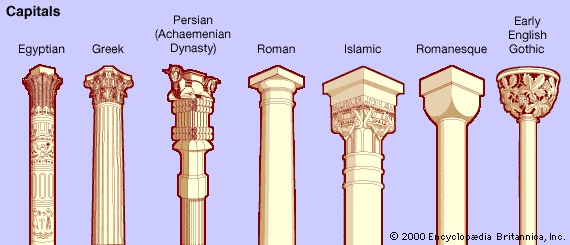capital
in economics, a stock of resources that may be employed in the production of goods and services. In classical economics it is one of the three factors of production, the others being labour and land. A brief treatment of capital follows. For full treatment, see capital and interest.
Capital may be so broadly defined as to include all possible material, nonmaterial, and human inputs into a productive system, but it is usually more useful to confine the term to material assets in the hands of productive enterprises. In this sense, there are two forms of capital. money or financial capital is a fluid, intangible form used for investment. Capital goods—i.e., real or physical capital—are tangible items such as buildings, machinery, and equipment produced and used in the production of other goods and services. Money capital is raised by selling stocks and bonds in order to finance the acquisition of real capital or capital goods. Capital goods are similar to savings because both require postponing current consumption to provide for future production and consumption.
In an accounting sense, the capital of a business firm is that part of the net worth that has not been produced by the operation of the enterprise, or, in other words, the original stock of net assets of the firm before any income is earned. The economist is more likely to speak of “real” assets, such as plant and equipment, factory and office buildings, and inventories of raw materials and of partly finished and finished goods, regardless of their financial status.
Economists of the classical school, beginning with Adam Smith, developed the earliest theory of capital, according to which capital arose out of the excess of production over consumption. The income earned by capital is profit, the counterpart to the wages and rent earned by the other factors of production. No thoroughly satisfactory theory of capital has been presented, and since the 19th century interest in developing such a theory has flagged.
architecture
 in architecture, crowning member of a column, pier, anta, pilaster, or other columnar form, providing a structural support for the horizontal member (entablature) or arch above. In the Classical styles, the capital is the architectural member that most readily distinguishes the order.
in architecture, crowning member of a column, pier, anta, pilaster, or other columnar form, providing a structural support for the horizontal member (entablature) or arch above. In the Classical styles, the capital is the architectural member that most readily distinguishes the order.Two simple forms of the capital are a square wooden block called an abacus, placed on the top of a post, and an oblong block called a billet, set with its greatest dimensions parallel to the beam above. Shaping the ends of such blocks produces a laterally spreading form of capital, which can be elaborated upon by multiplication of parts, addition of moldings, and ornamentation with floral, zoomorphic, or abstract forms.
Primitive abacus capitals were known in Egypt and Mesopotamia, and two kinds of simple stone capital have been found in the stepped-pyramid complex at Saqqārah (c. 2890–c. 2686 BC). One, a saddlelike shape, suggests bent reeds or leaves; the other, an upturned bell, derives from the papyrus plant. Later Egyptian architecture used capitals derived from such plant forms as the palm and lotus, as well as anthropomorphic forms and simple abacus shapes. Volute capitals (volute) were known in Hittite architecture in Anatolia and in Mesopotamia as early as 870 BC. Very elaborate capitals were created in Achaemenian Persia.
Three widely used forms of the capital were created by the Greeks. The Doric (Doric order) capital consists of a square abacus surmounting a round form with an egg-shaped profile called the echinus, below which are several narrow, ridgelike moldings linking the capital with the column. The Ionic (Ionic order) capital—probably related to the volute capitals of western Asia—has a tripartite design consisting of a pair of horizontally connected volutes inserted between the abacus and echinus. The Corinthian (Corinthian order) capital is basically an abacus supported on an inverted bell surrounded by rows of stylized acanthus leaves. The Romans added the Tuscan (Tuscan order) capital, a modified form of the Doric, and the Composite (Composite order) capital, which combined Ionic volutes with the Corinthian bell shape.
Islamic (Islamic arts) capitals, following the nonrepresentational requirement of the Muslim aesthetic, used primarily abstract forms derived from repetition of small moldings and multiplication of miniature arches. Some form of bracketed capital and a bell-shaped capital decorated with lotus motifs were used most frequently in India, China, and Japan.
Design of capitals in medieval (Middle Ages) Europe usually stemmed from Roman sources. Cubiform, or cushion, capitals, square on top and rounded at the bottom, served as transitional forms between the angular springing of the arches and the round columns supporting them. Grotesque animals, birds, and other figurative motifs characterize capitals of the Romanesque period. At the beginning of the Gothic period, exotic features tended to disappear in favour of simple stylized foliage, crockets, and geometric moldings, particularly in France and England. During the later Middle Ages, the emphasis on clustered columns and compound piers that soared in an unbroken line to high vaults tended to decrease the importance of the capital.
- ethylene
- ethylene bromide
- ethylene chloride
- ethylene glycol
- ethyl ether
- etiquette
- Etna, Mount
- Etobicoke
- Eton
- Eton College
- Etosha Pan
- etrog
- Etruscan
- Etruscan alphabet
- Etruscan language
- Etta Baker
- Etta James
- Etterbeek
- Ettore Arco Isidoro Bugatti
- Ettore Petrolini
- Etty, William
- etymology
- Etō Shimpei
- Euaʿ
- eubacterium